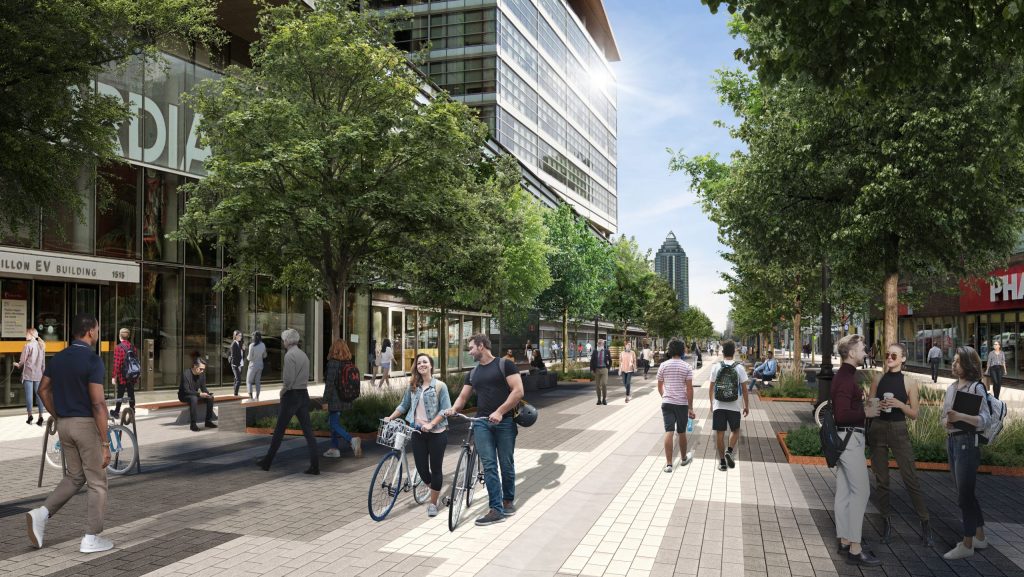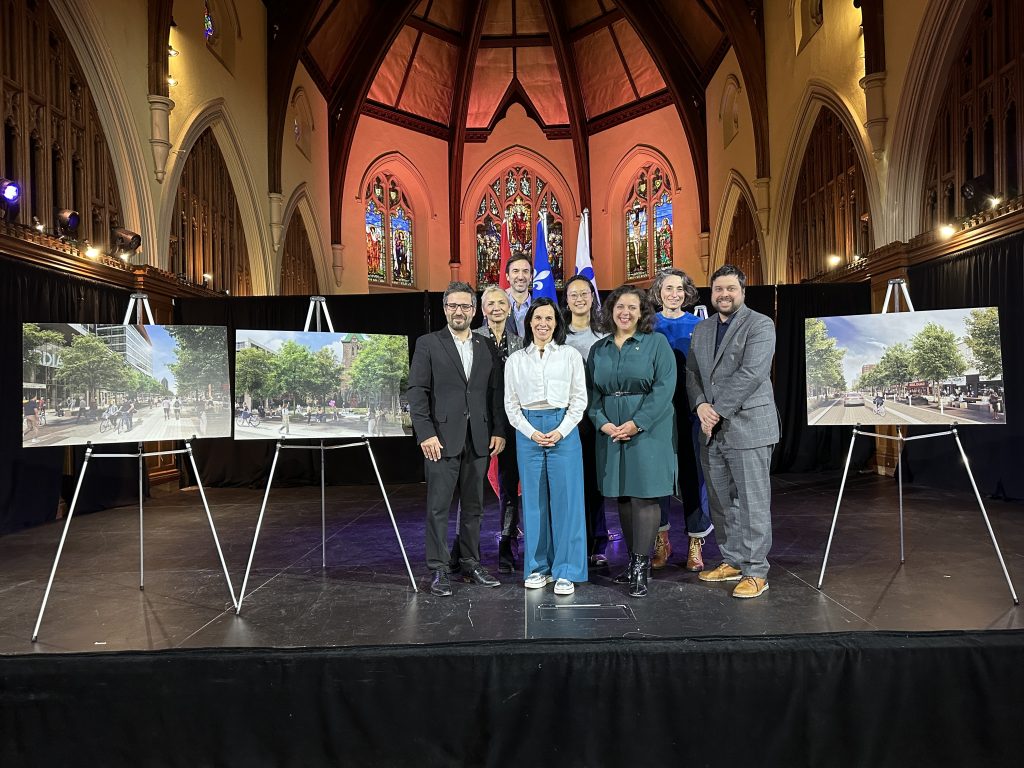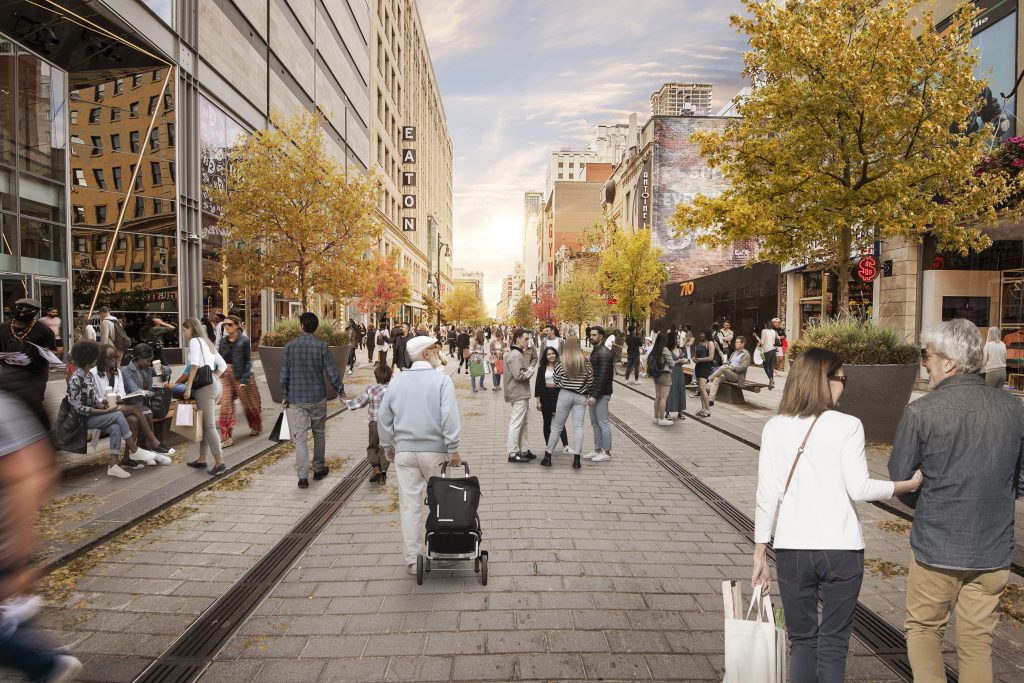Redevelopment of Sainte-Catherine Street: Montreal to create pedestrian-only public squares downtown

Posted November 27, 2024 2:43 pm.
Last Updated November 27, 2024 6:09 pm.
The City of Montreal is planning to build two pedestrian-only public squares downtown — turning parts of the metropolis’ most popular street car free.
The future Place McGill, between Robert-Bourassa Boulevard and Mansfield Street, is being touted as a “must-see destination in the heart of the city” by Mayor Valérie Plante.
Place Concordia, between Bishop and Guy streets, is described as a future “place to relax and an oasis of freshness.”
Plante announced the project at a press conference Wednesday.
“Just to fight climate change with having more green spots, and also support communities, I think this is the best way,” the mayor said.

Plante says the creation of the public squares are part of the major project to replace “outdated underground infrastructure” on Sainte-Catherine Street West, between Peel and Saint-Marc streets. That work is scheduled to begin in summer 2025.
“What we are announcing today is phase two of Sainte-Catherine,” she said. “We’ve already done the part one, that is a huge success. A lot of people are there now. And I think it was a good idea to put emphasis on consumers that are by foot, you know, like walking around, and now there’s bigger sidewalks and it’s good for businesses.”
The city says that urgent project created an opportunity for the city to “rethink the development of this emblematic commercial artery of the metropolis in order to strengthen its status as a must-see commercial destination, while improving the safety, comfort and experience of the people who frequent it.”
The city adds the new public squares, which were inspired by designs from other countries, will “calm vehicle traffic while maintaining accessibility to the street.”

No public consultation, downtown group laments
The group SDC Montréal Centre-Ville says it is seriously concerned by the proposal and is asking city officials to postpone the project to “allow for an in-depth discussion after the municipal elections” to take all concerns into account.
“Montréal has developed solid expertise in creating pedestrian streets. We know the recipe for successful pedestrianization, but for some reason, the city is ignoring the advice of experts and proposing a concept that has never proven itself,” said the group’s executive director Glenn Castanheira. “A project of this magnitude requires rigorous planning, a thorough assessment of its impacts and, above all, a genuine dialogue with all parties concerned.
“Rushing such an initiative in a context where there is no urgency to act would be a mistake. The municipal administration would be well advised to wait until the next election to establish an inclusive and transparent process. The success of the new Sainte-Catherine Street depends, among other things, on citizen participation. The lack of public consultation as part of this new project is a regrettable omission that jeopardizes its success.”
Castanheira claims major businesses that will be affected were not involved in the discussions at all.
“We’re talking about the largest commercial street in Canada,” he told CityNews. “Just a stretch in front of the Eaton Centre is worth $100 million of revenues per year for the City of Montreal. Eaton Centre just found out about this project last night. So clearly there were no public consultations. There is a path to success with this project. It is not the one that has been put in place by the City of Montreal.”

Montréal Centre-Ville says it told the Plante administration earlier this summer that only 11 per cent of survey respondents support permanent pedestrianization.
“These figures highlight the importance of concerted reflection before proceeding with such significant transformations,” the group said in a news release.
‘It will kill Sainte-Catherine Street’
Federico Sanchez, director of communications at Le Pois Penché, feels there’s been a lot of secrecy around this project, saying merchants should have been consulted as it affects their livelihood.
“What’s important now is that one business out of four in the neighbourhood where we stand is closed,” Sanchez said. “Empty stores. That’s 25 per cent inoccupancy rate. That’s absolutely unacceptable for what was once the most prosperous neighbourhood in Canada. It’s completely unacceptable. Anything that the administration has done to date hasn’t changed that.”
“It will create a nightmare for traffic, a nightmare for the merchants, a nightmare also for the residents of the neighbourhood, and it will kill Sainte-Catherine Street West,” added Serge Sasseville, an independent city councillor in the Peter-McGill district of Ville-Marie.
Anticipating that backlash from those who argue pedestrianizing the city’s downtown core hurts businesses, the city says “this project is inspired by studies that have shown that in the presence of a commercial artery located in a city centre, the majority of revenues come from customers who travel in active mode.”
“If there’s business owners that feel like they haven’t been consulted, I want to tell them and it’s very important that we’ve been working, we’ve been talking to the different stakeholders, the business association of Sainte-Catherine, other ones, the Crescent one, everybody,” said Mayor Plante. “We’ve been talking to them in the last two years, bringing, collecting information and issues because there’s also issues with any type of ‘réaménagement.’ And I really feel today that we’re coming up with the best compromise we could.”
The group Peter-McGill Community Table says it supports the city’s plan for the redevelopment of Sainte-Catherine Street.
“More than 45,000 people live there, including thousands of young people, families and seniors, who need spaces to gather and move. These esplanades will certainly encourage seniors, families and young people to get out of the big towers, which will contribute to their physical and mental health,” said the group’s director Stéphane Febbrari.








